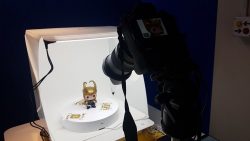Dimitri’s research focuses on creating a content creation, presentation and sharing platform using adaptable Photogrammetry 3D scanning technology to create 3D models of physical objects, and then combining them with Mixed Reality (MR) techniques to create engaging interaction experiences.
Between September 2017 and March 2018, Dimitri will use this impact grant to:

The above work will be carried out under the existing Mixed Reality Storytelling brand, a project that has already received successful impact by delivering a multi-part public exhibit (consisting of an AR exhibition and a 3D scanning both) at The National Videogame Arcade in Nottingham.
Between 28 September and 8 October, Dimitri’s 3D scanning technology was used to make 3D models of the objects produced in an art exhibition held at Tate in London, Factory: The Seen and the Unseen, where the entire floor of the new Tate Exchange building was turned into a ceramics factory for the public to create and share objects.
Dimitri submitted his PhD thesis entitled ‘The Lives of Objects: Designing for Meaningful Things’ in September 2017, and passed his viva on 30 November 2017.